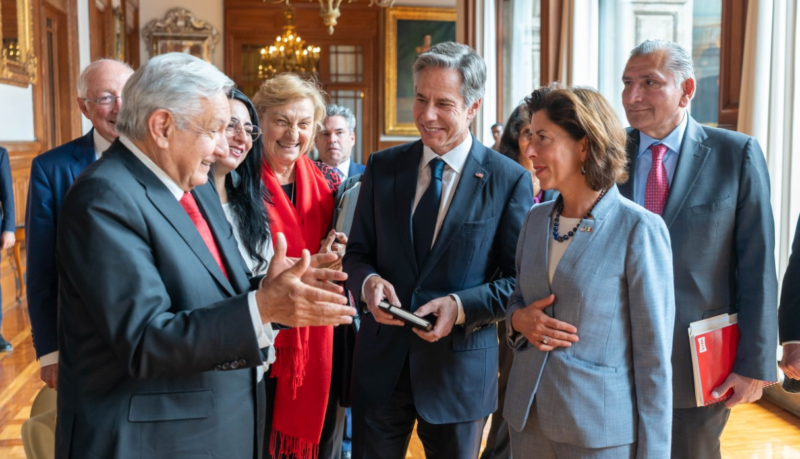Mexico: How Far Have its Institutions Really Come?
The question remains if Mexico has achieved a degree of institutional development consistent with its participation in those organizations.
A Daily Publication of The Dialogue
U.S. Secretary of State Antony Blinken led a delegation to Mexico City on Sept. 12 for an annual meeting of the U.S.-Mexico High-Level Economic Dialogue (HLED). The U.S. delegation focused its agenda on two recently enacted U.S. laws: the $280 billion Chips and Science Act, which fosters semiconductor manufacturing, and the Inflation Reduction Act, which the administration hopes will advance cooperation in the renewable energy sector in Mexico. Meanwhile, Mexican officials focused on security ties. What were the most important advances to come out of the recent talks, and what new avenues of cooperation will they lead to between the United States and Mexico? What is the state of U.S.-Mexico economic relations, and what are the biggest problems in the trade relationship that need to be worked out?
Michael C. Camuñez, president & CEO of Monarch Global Strategies, former U.S. assistant secretary of commerce and principal architect of the U.S.-Mexico High Level Economic Dialogue: “The HLED was born in 2013 from the recognition that our two nations desperately need an appropriate platform to discuss, at the highest levels, strategic issues related to our long-term global competitiveness. The reality is that Mexico historically had not received the attention it deserved in Washington. More recently, painful supply chain disruptions from the pandemic, together with increasing tensions with China, have highlighted the value and importance of this key bilateral relationship. The passage of the CHIPS and IRA bills now creates an urgent and compelling reason for the HLED to kick into action. In short, the HLED may finally be realizing its highest potential, helping the United States and Mexico to advance a truly strategic economic and trade agenda. That at least is the headline takeaway from Mexico City last week, and the Biden administration leaders who are pushing the agenda deserve a lot of credit for their efforts to bring Mexico along despite numerous ongoing challenges. But will Mexico rise to the moment and meet the ambition of its North American partners? The jury is still out. Mexico clearly can provide what the Inter-American Development Bank describes as the ‘labor-intensive, back-end’ link of the semiconductor global value chain. But it will need to do far more than provide some economic incentives to would-be investors. Mexico must show that it can provide a predictable, fair and transparent business climate. It must get its security situation under control, giving confidence that such expensive and valuable commodities can be safely transported in the country. And it must support access to renewable energy for global manufacturers who are under enormous investor pressure to utilize clean energy resources throughout their supply chain. Mexico confronts a once-in-a-lifetime opportunity to compete in the major leagues. I’m hoping the country is ready to play ball.”
Evren Çelik Wiltse, associate professor and program lead for political science at the School of American & Global Studies at South Dakota State University: “The Covid-19 pandemic, disruption of global supply chains, Russia-Ukraine war and the dual crisis of global food and energy once again exposed the myth of self-sufficiency. It became clear that those with a large and diverse economic footprint have better chances to weather these storms. The complementary nature of the U.S. and Mexican economies provides immense opportunities for both. Economic growth and development in Mexico from hi-tech industries to agriculture progressively reduces the vulnerability of North America in times of turmoil. The Gulf of Mexico is in the process of transforming itself to be the new renewable energy hub. With alternative energy sources, it is still more cost effective to utilize existing energy infrastructure and grids in the gulf than start from scratch elsewhere. Today, top performing economies in the world want access to greater markets with as few barriers as possible. The European Union enjoys economies of scale that come with its 27 member nations and more than 500 million people. Germany could not have been the manufacturing giant that it is without factories in Poland and Eastern Europe. China is spearheading Shanghai Cooperation Council (SCO) with more than a dozen nations in Asia, including Russia. Despite fierce competition, the United States and Mexico have significant advantages over these regions. Security concerns of NAFTA/USMCA arise not from wars with neighbors, but rather from non-state actors. However, the European Union is facing a massive war at its borders, and members of SCO had military confrontations with each other even during the SCO Summit. There is no better time than now to enjoy the peace dividend in North America and intensify U.S.- Mexico collaboration.”
Amy Glover, president and founding partner of Agil(e): “The HLED is an important government-to-government mechanism and the focus on strengthening North American supply chains is the right one. That said, the widely disparate visions of what is required for an energy transition have placed ominous dark clouds over the bilateral relationship. Thankfully, the U.S.-Mexico economic relationship is simply too vital to be put in undue jeopardy, particularly from a Mexican standpoint. In fact, to date the only political force able to make President Andrés Manuel López Obrador think twice and even back down on occasion—without admitting it, of course—has been the U.S. government. The nationalistic and protectionist policies that favor the state-owned companies CFE and Pemex frustrate the move toward a greater reliance on clean energy. They are concerning from both a regional competitiveness and a climate perspective. The U.S. government does not want a political row, but the decision—together with Canada—to request dispute settlement consultations over violations to Mexico’s USMCA commitments is serious. The U.S. and Canadian chambers of commerce in Mexico have wisely called for the three governments to discuss their differences ahead of formal consultations that would begin next year. While it is hard to see a clear path to resolution, the political temptation for AMLO to thumb his nose at the gringos will likely be outweighed by the economic and investment pressures that can be brought to bear in the run up to the 2024 presidential election. If AMLO expects to ensure a win for his party, he will need to avoid more dour economic news. Disgruntlement over inflation and slow economic growth is on the rise. An economy that will crawl along at around 1 percent GDP growth this year and next is simply not much to brag about.”
Tapen Sinha, professor of risk management at the Instituto Tecnológico Autónomo de México and professor at the University of Nottingham Business School: “According to the White House, the HLED continues to focus on four central pillars: 1.) Building Back Together; 2.) Promoting Sustainable Economic and Social Development in Southern Mexico and Central America; 3.) Securing the Tools for Future Prosperity; and 4.) Investing in Our People. The Biden administration has secured a $1.5 billion commitment from the Mexican government to strengthen border security. This development stands in contrast with what the previous U.S. administration managed to do. The second goal has not shown many results. The tide of Central Americans coming through Mexico to reach the United States has not shown any sign of slowing down. Conditions in El Salvador or Guatemala for potential recruits for drug cartels have not improved. In July, the United States escalated a trade dispute under the USMCA by announcing that it would initiate a ‘consultation’ process about Mexican energy policy that was seen to be violating the USMCA. This action typically leads to tariffs on other products. Canada immediately sided with the United States. Probably the best thing that came out of the HLED was an easing of the U.S. rhetoric in the past week. Both sides are talking with each other again. It will be followed up by a visit to the United States by Mexican Foreign Secretary Marcelo Ebrard. The two countries could avoid a major trade war escalation in North America.”
 The Latin America Advisor features Q&A from leaders in politics, economics, and finance every business day. It is available to members of the Dialogue’s Corporate Program and others by subscription.
The Latin America Advisor features Q&A from leaders in politics, economics, and finance every business day. It is available to members of the Dialogue’s Corporate Program and others by subscription.
The question remains if Mexico has achieved a degree of institutional development consistent with its participation in those organizations.
Focusing on transnational crime is a top priority of the Obama administration’s policy in Latin America.
Despite reports in recent months that Mexican manufacturing is experiencing a resurgence, Mexico’s industrial sector faces tremendous challenges.
 Mexican President Andrés Manuel López Obrador met with U.S. officials including Secretary of State Antony Blinken and Commerce Secretary Gina Raimondo this month during high-level talks in Mexico City. // Photo: @SecBlinken via Twitter.
Mexican President Andrés Manuel López Obrador met with U.S. officials including Secretary of State Antony Blinken and Commerce Secretary Gina Raimondo this month during high-level talks in Mexico City. // Photo: @SecBlinken via Twitter.